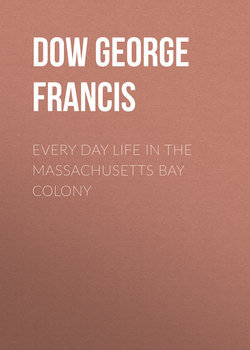Every Day Life in the Massachusetts Bay Colony

Реклама. ООО «ЛитРес», ИНН: 7719571260.
Оглавление
Dow George Francis. Every Day Life in the Massachusetts Bay Colony
PREFACE
CHAPTER I. The Voyage To Massachusetts
CHAPTER II. Their Early Shelters and Later Dwellings
CHAPTER III. How They Furnished Their Houses
CHAPTER IV. Counterpanes and Coverlets
CHAPTER V. Concerning Their Apparel
CHAPTER VI. Pewter in the Early Days
CHAPTER VII. The Farmhouse and the Farmer
CHAPTER VIII. Manners and Customs
CHAPTER IX. Sports and Games
CHAPTER X. Trades and Manufactures
CHAPTER XI. Concerning Shipping and Trade
CHAPTER XII. From Wampum To Paper Money
CHAPTER XIII. Herb Tea and the Doctor
CHAPTER XIV. Crimes and Punishments
APPENDIX A. Building Agreements in Seventeenth-Century Massachusetts
APPENDIX B. Rev. Samuel Skelton's Accompte (1629-1630)
APPENDIX C. An Abstract of the Inventory of Contents of the Shop of Capt. Joseph Weld of Roxbury, made February 4, 1646-7
APPENDIX D. Abstract of an Inventory of the Goods of Capt. Bozone Allen, Shopkeeper, of Boston, Deceased, made Sept. 22, 1652, by Edward Hutchinson and Joseph Rock
APPENDIX E. Manufactures and Other Products Listed in the Rates on Imports and Exports Established by the House of Parliament, June 24, 166096
APPENDIX F. Copy of the Inventory of the Estate of Wm. Paine ofBoston, Merchant, Appraised by Hen. Shrimpton,Joshua Scottow and John Richards, and Allowedin Court at Boston, Nov. 14, 1660, UponOath of Mr. John Paine, His Son
APPENDIX G. Inventory of the Estate of Edward Wharton of Salem, Deceased, and What Goods were in His Possession, Consigned to Him by Several, Taken 12:1:1677-8, by Hilliard Veren, sr., John Hathorne and John Higginson, jr
APPENDIX H. Inventory of the Estate of Capt. George Corwin of Salem, Taken by Barthl. Gedney, Benja. Browne, John Higginson Junr. and Timo. Lindall on Jan. 30 and the Beginning of Feb., 1684-5
Отрывок из книги
"Before you come," wrote Rev. Francis Higginson, the first minister at Salem, "be careful to be strongly instructed what things are fittest to bring with you for your more comfortable passage at sea, as also for your husbandry occasions when you come to the land. For when you are once parted with England you shall meete neither markets nor fayres to buy what you want. Therefore be sure to furnish yourselves with things fitting to be had before you come: as meale for bread, malt for drinke, woolen and linnen cloath, and leather for shoes, and all manner of carpenters tools, and a great deale of iron and steele to make nails, and locks for houses, and furniture for ploughs and carts, and glasse for windows, and many other things which were better for you to think of there than to want them here."1 Elsewhere the good pastor set down "A catalogue of such needfull things as every Planter doth or ought to provide to go to New England" in which he enumerated the necessary victuals per person for the first year, viz.:
"8 Bushels of meale, 2 Bushels of pease, 2 Bushels of Otemeale, 1 Gallon of Aquavitae, 1 Gallon of Oyle, 2 Gallons of Vinegar, 1 Firkin of Butter; also Cheese, Bacon, Sugar, Pepper, Cloves, Mace, Cinnamon, Nutmegs and Fruit."
.....
A word or two as to the varying types of house hardware may not be amiss at this time. At the outset wooden hinges and heavy strap hinges of wrought iron were in common use. These hinges were hung on gudgeons and their points varied in design but the spear-shaped point was most common. In the best houses, at an early date and continuing until the beginning of the eighteenth century, might be found the so-called "cock's head" hinge, an ornamental survival from Roman times. The butterfly hinge was also in use at that time – usually on cupboards and furniture doors. The H and HL hinges came into use in New England in the early 1700's and lasted until after the Revolution. These hinges were cut out of heavy sheet iron and were made in factories in England. This type of hinge was superseded by the cast-iron butt, still in use, which was invented in England in 1775, and adopted very generally in the United States at the close of the Revolution.
In some old houses that have been restored and in many modern constructions done in the manner of the seventeenth and eighteenth centuries, the door hinges in painted rooms have been picked out in black making them most conspicuous. This is a modern conceit – an invention of the modern architect. It was not done in the old days, a fact easily established by carefully scraping through the various coats of paint on an old house. Our great-great-grandmothers had no itching desire for contrasts of that sort. They knew nothing of highboys, grandfather's clocks, low daddys, Lady Washington chairs, courting mirrors, fiddle back chairs or donkey-eared spindle backs. These names are inventions of collectors or antique dealers striving for the picturesque. The highboy, it is true, antedates the others, but in the early days this piece of furniture was called a high chest of drawers and the lowboy was called a low chest. Recently the common HL hinge has been described as the "Holy Land" hinge; certainly not referring to the English colonies where there were fully as many sinners as saints.
.....